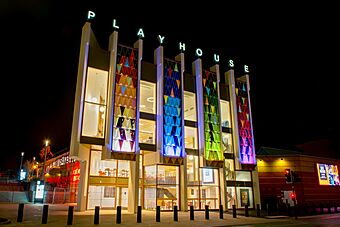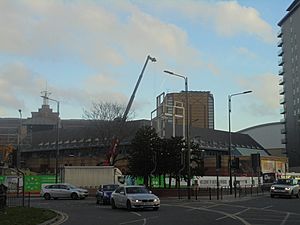Leeds Playhouse facts for kids
 |
|
| Address | Playhouse Square, Quarry Hill, Leeds LS2 7UP West Yorkshire England |
|---|---|
| Coordinates | 53°47′53″N 1°32′03″W / 53.79819°N 1.53428°W |
| Owner | Leeds Theatre Trust Ltd (Registered charity 255460) |
| Capacity | Quarry Theatre 750 Courtyard Theatre 350 |
| Opened | March 1990 |
The Leeds Playhouse is a well-known theatre located in the city centre of Leeds, West Yorkshire, England. It first opened its doors in 1990 in the Quarry Hill area. Back then, it was called the West Yorkshire Playhouse. In June 2018, it changed its name back to "Leeds Playhouse".
This theatre has two main performance halls and a smaller studio space. It puts on a wide variety of plays and shows. The Playhouse also works with the local community, offering different programs and activities.
Contents
History of Leeds Playhouse
The idea for Leeds Playhouse began with the Leeds Playgoers' Society. This group started in 1907. They wanted to put on new plays by famous writers like Shaw and Ibsen.
Starting the First Playhouse
In 1964, people started campaigning for a permanent theatre in Leeds. They wanted a place for modern plays. Even though some local council members thought Leeds already had a theatre (the Grand Theatre), a public fundraising event was held.
This big meeting took place in Leeds Town Hall on May 5, 1968. Famous people like Peter O'Toole and Keith Waterhouse spoke there. The public raised £20,000. The Leeds City Council then promised £25,000 and more money each year if needed.
With help from the Arts Council and the Gulbenkian Foundation, the project could go ahead. The first Leeds Playhouse opened in 1970. It was in a building loaned by the University of Leeds.
First Performance and Famous Actors
The very first show was on September 16, 1970. It was a play called Simon Says by Alan Plater. Tony Robinson, who later became famous as Baldrick in Blackadder, starred in it. The next month, Tony Robinson also acted in William Shakespeare's The Merry Wives of Windsor.
Moving and Rebranding
The Leeds Playhouse moved to the Quarry Hill area in March 1990. This move was part of a big plan to improve that part of the city. At this time, it became known as the West Yorkshire Playhouse.
In June 2018, the theatre changed its name back to Leeds Playhouse. This was to show its connection to the growing city of Leeds. It also recognized the long-term support from the Leeds City Council.
The Playhouse Building
The Leeds Playhouse building was designed by The Appleton Partnership architects. It has several important parts.
Inside the Theatre
The complex includes two main theatres:
- The Quarry Theatre, which can seat 750 people.
- The Courtyard Theatre, which has 350 seats.
There is also a bar and a restaurant. The building has two special rooms for events, called the Congreve Room and the Priestley Room. There are three spaces for rehearsals, a recording studio, and workshops for building sets. It also has dressing rooms, a costume hire department, and offices for the theatre's teams.
Judi Dench, a famous actress, laid the foundation stone in 1989. Another famous actress, Diana Rigg, opened the theatre when it was finished. The building cost £13 million to build.
Recent Improvements
In 2019, the building had a big upgrade that cost £16.8 million. These changes created a new entrance area (foyer). They also made it easier for everyone to move around the building. The front of the building was moved to face the city better. A new studio space, called the Bramall Rock Void, was also created, which can seat 130 people.
Productions and Shows
Leeds Playhouse is known across the country and even internationally. It has won awards for its shows and its excellent customer service. It is one of the biggest regional theatres in the UK outside of London.
Artistic Directors
The first artistic director of the theatre was Jude Kelly. She led the theatre from 1990 to 2002. After her, Ian Brown took over. Since 2012, James Brining has been the artistic director.
Types of Performances
The theatre puts on a wide range of shows. These include classic plays, modern European theatre, and special shows for children. The Playhouse also focuses on new plays, especially those written by people from the north of England.
Many shows are created with other theatres. Some of these shows then travel around the country or move to London theatres. Other theatre groups, like Northern Broadsides and Kneehigh Theatre, also visit and perform at the Playhouse.
The musical Spend Spend Spend first started at Leeds Playhouse. This show tells the story of Viv Nicholson, who won a lot of money in the football pools in 1961.
A Typical Season
A typical season at the Playhouse includes four or five big productions. These shows usually run for three or four weeks. There are also shorter shows, lasting one week or less. These might be by visiting theatre companies.
For example, a recent season included a play about Casanova and a stage version of Don Quixote. They also had Brief Encounter and Rough Crossings. The theatre also puts on Christmas shows, often one for small children and another bigger production. The Playhouse is known for supporting new writers, like Zodwa Nyoni.
Financial Support
The Leeds Playhouse gets money from different places. Arts Council England gives it about £1,500,000. Leeds City Council also provides around £670,000. The theatre also gets support from companies that sponsor its work.
Images for kids



